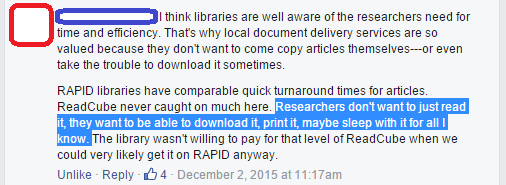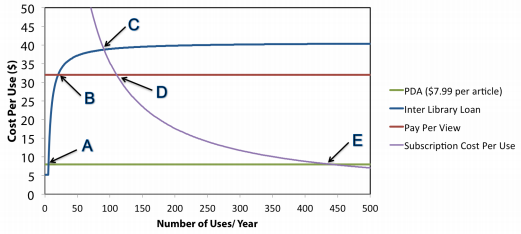 I’ve long been fascinated with the implications of demand-driven eBook acquisition models (DDA) at academic libraries (Great primer on DDA here). Particularly with interesting things happening such as Evidence Based Acquisition or, in the public library sphere, Hoopla.
I’ve long been fascinated with the implications of demand-driven eBook acquisition models (DDA) at academic libraries (Great primer on DDA here). Particularly with interesting things happening such as Evidence Based Acquisition or, in the public library sphere, Hoopla.
However, having worked for a small research library that processed a large amount of ILL article requests, I’ve also been extremely curious about demand-driven journal article acquisition. Journal article DDA hasn’t caught on as much as eBook DDA. The reasons for this (as I see them) are:
Academic Libraries use eBook DDA but why not Journal Article DDA? pic.twitter.com/dpayHuqqMT
— Ryan Regier (@ryregier) October 30, 2015
However, I missed one of the biggest ones on this list. I want discuss this one here.
One of the few growing journal article DDA services is Checkout. It’s a service that allows users three options to access an article:
- Rent a DRM-restricted article for 48 hours for $3.99.
- Purchase cloud access to an DRM-restricted article for $9.99.
- Download a PDF copy of the article with no usage restrictions for $25.00
For the first two options, the article can only be accessed through ReadCube software (Which is like Mendeley or Zotero, allowing the user the ability to highlight, make notes, organize, cite, cloud storage, and synchronize across devices), and cannot be printed or saved to your computer. However, you can access the articles offline, but only through ReadCube software. For the last option – and the most expensive one – the user owns a PDF copy of the article and can print or save it where they please.
Now ReadCube currently only has DDA options from two publishers: Springer Nature and Wiley. There has also been some justified anger in how Wiley has been trying to force their readers to use ReadCube.
However, despite these issues, a recent paper by England, Weisbrod, and Jarvis (2015) [#paywalled. Sorry] shows how ReadCube resulted in increased access and cost savings at the University of Utah:
That’s some pretty serious savings.
Interestingly, the University of Utah only offered their users access to the ReadCube rent and cloud copy options. They had tried testing out offering the DRM-free PDF option and found that, unsurprisingly, 80% of user chose that option. Annnd at 25 bucks a pop, it’s an option that doesn’t lead to the library saving money.
And, I mean, given the option, why would you not chose the DRM-free PDF if you wanted an article? Chances are you would want access to the article for more then 48-hours (especially if you plan on citing it) and that you might want to print it out or share it with a friend.
This is has been one of the main arguments put forward against Readcube. That users want to own the articles they read/use. England, Weisbrod, and Jarvis talk about coming across this complaint often. It even made its way onto a Facebook Group on ILL:

Ha! But it is true. Researchers are used to owning their own individual copy of an article, there is a special relationship there. That’s not changing.
Or is it?
What about eBooks? We’ve gotten pretty used to the idea that we don’t own eBooks anymore. We now put up with endless DRM-restrictions on eBooks. But we won’t do this for articles?
What about streaming services like Netflix and Spotify? These services are also proof that we don’t need to own tangible, physical copies of works to use and be satisfied by them.
To give a biased, personal example (This is a blog after all): I used to print out a lot of articles in order to read and highlight them. However, once Mendeley’s Android app launched, I stopped printing them out and now read all my articles on my phone (I have a big phone). It is waayy more convenient than reading printed articles (You can’t curl up on a couch so easily with a printed article) or reading it on my laptop.
Also I can highlight and take notes with the app. And- the best part- I can use the Mendeley citation plugin to easily cite these articles later when writing on my laptop.
I don’t interact with these articles beyond my Mendeley software software. I imagine this probably the same for a growing number of researchers using Mendeley, Zotero, or other citation tools.
Essentially then, every article I have on Mendeley is equivalent to being a Cloud Option article on ReadCube.
So maybe DDA for journal articles from services like Readcube is it bit more likely than we think it is. There is no denying the amount of money that University of Utah saved with their subscription. And researchers preferences with electronic formats are always changing.
Also looking back on the tweet above where I listed why Libraries are staying away from DDA for articles, I think it’s pretty clear that all of those issues could be easily solved by an enterprising library.
The question if DDA for journal articles is actually a good thing for researchers and libraries is a whole another question and a topic for a different blog post.
Last Thing: To get a better idea of what ReadCube is doing I recommend reading this article [Open Access!] by England and Jones (2014) which also talks about the ReadCube experiment at University of Utah.
Particularly this graph they created which shows which method of access for journals articles is most cost effective versus usage [for a deeper explanation of the graph and what the letters are pointing too, please read the article]:


One thought on “Is Demand Driven Access to Journal Articles the Future?”